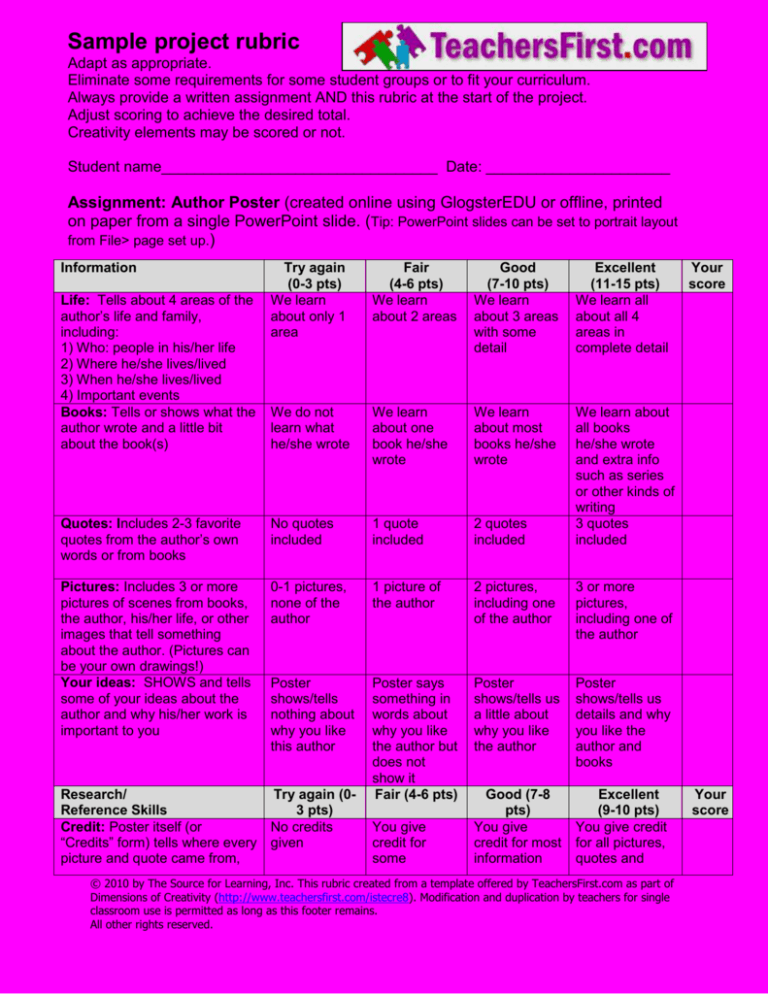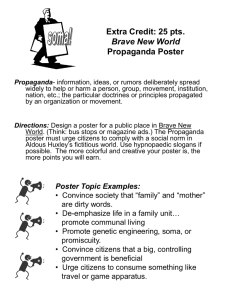
Sample project rubric
Adapt as appropriate.
Eliminate some requirements for some student groups or to fit your curriculum.
Always provide a written assignment AND this rubric at the start of the project.
Adjust scoring to achieve the desired total.
Creativity elements may be scored or not.
Student name_________________________________ Date: ______________________
Assignment: Author Poster (created online using GlogsterEDU or offline, printed
on paper from a single PowerPoint slide. (Tip: PowerPoint slides can be set to portrait layout
from File> page set up.)
Information
Try again
(0-3 pts)
We learn
about only 1
area
Fair
(4-6 pts)
We learn
about 2 areas
Good
(7-10 pts)
We learn
about 3 areas
with some
detail
Excellent
(11-15 pts)
We learn all
about all 4
areas in
complete detail
We do not
learn what
he/she wrote
We learn
about one
book he/she
wrote
We learn
about most
books he/she
wrote
Quotes: Includes 2-3 favorite
quotes from the author’s own
words or from books
No quotes
included
1 quote
included
2 quotes
included
We learn about
all books
he/she wrote
and extra info
such as series
or other kinds of
writing
3 quotes
included
Pictures: Includes 3 or more
pictures of scenes from books,
the author, his/her life, or other
images that tell something
about the author. (Pictures can
be your own drawings!)
Your ideas: SHOWS and tells
some of your ideas about the
author and why his/her work is
important to you
0-1 pictures,
none of the
author
1 picture of
the author
2 pictures,
including one
of the author
3 or more
pictures,
including one of
the author
Poster
shows/tells
nothing about
why you like
this author
Poster says
something in
words about
why you like
the author but
does not
show it
Fair (4-6 pts)
Poster
shows/tells us
a little about
why you like
the author
Poster
shows/tells us
details and why
you like the
author and
books
Good (7-8
pts)
You give
credit for most
information
Excellent
(9-10 pts)
You give credit
for all pictures,
quotes and
Life: Tells about 4 areas of the
author’s life and family,
including:
1) Who: people in his/her life
2) Where he/she lives/lived
3) When he/she lives/lived
4) Important events
Books: Tells or shows what the
author wrote and a little bit
about the book(s)
Research/
Try again (0Reference Skills
3 pts)
Credit: Poster itself (or
No credits
“Credits” form) tells where every given
picture and quote came from,
You give
credit for
some
© 2010 by The Source for Learning, Inc. This rubric created from a template offered by TeachersFirst.com as part of
Dimensions of Creativity (http://www.teachersfirst.com/istecre8). Modification and duplication by teachers for single
classroom use is permitted as long as this footer remains.
All other rights reserved.
Your
score
Your
score
as well as where you learned
about the author’s life.
information
you used
you used
information you
used
Creativity Skills
(FFOE) assign only THREE for
a score of 100
Working on
it
(1 pt)
Good (2-3
pts)
Excellent
(4-5 pts)
Fluency: You collected lots of
possible ideas for ways to do
this project
You talked a
little with
another
person about
what you
would put in
your poster
We can tell
the audience
is supposed
to be
different, but
we are not
sure who it is
You wrote
down an idea
or two before
starting the
poster
You made a
written or
computer
brainstorm of
ideas for your
poster before
you started it
We can tell who
the different
audience is,
and all the
words and
pictures fit this
audience
Flexibility: Poster “sells” the
author to an audience other
than student readers (Ex.
animals, parents, aliens,
bookstore owners, etc).
Originality: Poster uses
unusual/unexpected ways to
show and tell about the author
One or two
words or
pictures are
unusual or
unexpected
We can tell
who the
different
audience is,
and most
words and
pictures fit
this audience
Some of the
pictures or
words are
unusual or
unexpected
Elaboration: Poster has extra
details in both words and
pictures that all fit the poster’s
“message.”
One or two
extra details
(words or
pictures) that
fit the poster’s
“message.”
Some extra
details (words
and/or
pictures) that
fit the poster’s
“message.”
Your poster
uses unusual or
unexpected
pictures/words
to show and tell
about the
author
Many extra
details (words
and pictures)
that fit the
poster’s
“message.”
Total
score
Student comments about my poster:
Teacher comments:
© 2010 by The Source for Learning, Inc. This rubric created from a template offered by TeachersFirst.com as part of
Dimensions of Creativity (http://www.teachersfirst.com/istecre8). Modification and duplication by teachers for single
classroom use is permitted as long as this footer remains.
All other rights reserved.
Your
score







